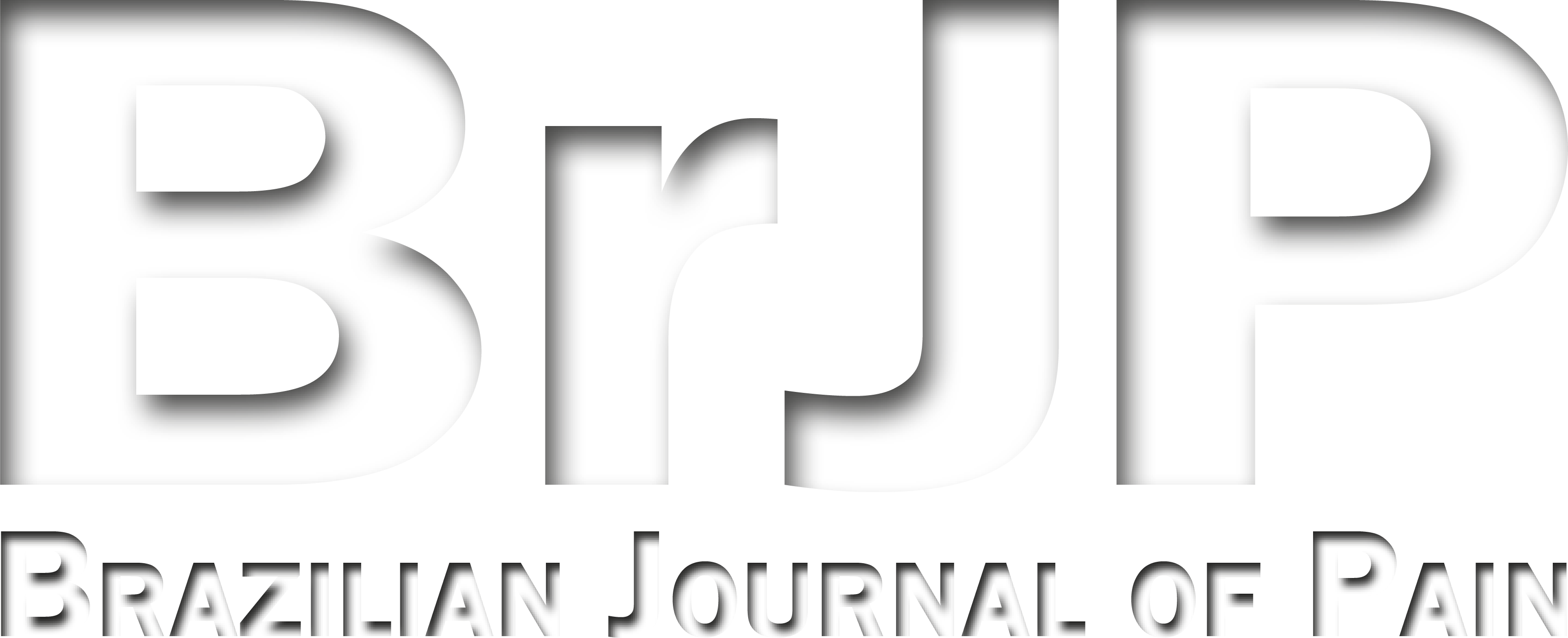Topical anesthetic to release trigger points in painful myofascial syndrome. Pilot study
Anestésico tópico para liberação de pontos-gatilhos em síndrome dolorosa miofascial. Estudo piloto
Ana Paula de Oliveira Maciel; Matheus Henrique Lopes Dominguete; José Dias da Silva Neto
Abstract
Keywords
Resumo
Palavras-chave
References
Yeng LT, Hideko H, Kaziyama S, Teixeira MJ. Myofascial pain syndrome. Rev Med. 2001;80(1):94-110.
Borg-Stein J, Iaccarino MA. Myofascial pain syndrome treatments. Phys Med Rehabil Clin N Am. 2014;25(2):357-74.
Dommerholt J, Grieve R, Hooks T, Finnegan M. A critical overview of the current myofascial pain literature - January 2017. J Bodyw Mov Ther. 2017;21(1):141-7.
Fricton J. Myofascial Pain: Mechanisms to management. Oral Maxillofac Surg Clin North Am. 2016;28(3):289-311.
Kuan TS. Current studies on myofascial pain syndrome. Curr Pain Headache Rep. 2009;13(5):365-9.
Simons DG. New views of myofascial trigger points: etiology and diagnosis. Arch Phys Med Rehabil. 2008;89(1):157-9.
Ay S, Konak HE, Evcik D, Kibar S. The effectiveness of Kinesio Taping on pain and disability in cervical myofascial pain syndrome. Rev Bras Reumatol. 2017;57(2):93-9.
Travell JG, Simons DG. Myofascial Pain and Dysfunction: The Trigger Point Manual. 1992.
Shah JP, Thaker N, Heimur J, Aredo J V, Sikdar S, Gerber L. Myofascial trigger points then and now: a historical and scientific perspective. PM&R. 2015;7(7):746-61.
Borg-Stein J, Simons DG. Myofascial pain. Arch Phys Med Rehabil. 2002;83(3^sSuppl 1):S40-7.
Lavelle ED, Lavelle W, Smith HS. Myofascial trigger points. Anesthesiol Clin. 2007;25(4):841-51.
Fisher A. Muscle pain: basic algorithm for pain management. 1995;1(1).
Flores MP, Castro AP, Nascimento J. Analgésicos tópicos. Rev Bras Anestesiol. 2012;62(2):248-52.
Kaweski S. Topical anesthetic creams. Plast Reconstr Surg. 2008;121(6):2161-5.
Gerwin R. Botulinum toxin treatment of myofascial pain: A critical review of the literature. Curr Pain Headache Rep. 2012;16(5):413-22.
Karaca I, Yapca OE, Adiyeke M, Toz E, Karaca S Yildirim. Effect of cervical lidocaine gel for pain relief in pipelle endometrial sampling. Eurasian J Med. 2017;48(3):189-91.
Bron C, Dommerholt J, Stegenga B, Wensing M, Oostendorp RA. High prevalence of shoulder girdle muscles with myofascial trigger points in patients with shoulder pain. BMC Musculoskelet Disord. 2011;12(1):139.
Roman-Torres CV, Brandt WC, Muller KC, Cortelli SC, Aquino DR, Schwartz-Filho HO. Avaliação dos diferentes métodos utilizados no tratamento da síndrome dolorosa miofascial. Rev Gestão Saúde. 2015;12:1-9.
Batalha LM, Carreira MC, Correia MM. Dor para não ter dor: aplicação de anestésico tópico. Rev Enferm Ref. 2011;III Série(5):203-9.
Babaie S, Ghanbarzadeh S, Daravan S, Kouhsoltani M, Samishehkar H. Nanoethosomes for dermal delivery of lidocaine. Adv Pharm Bull. 2015;5(4):549-56.
Kalichman L, David C Ben. Effect of self-myofascial release on myofascial pain, muscle flexibility, and strength: a narrative review. J Bodyw Mov Ther. 2016;21(2):446-51.
Giordano D, Raso MG, Pernice C, Agnoletti V, Barbieri V. Topical local anesthesia: focus on lidocaine-tetracaine combination. Local Reg Anesth. 2015;8:95-100.
Gupta P, Singh V, Sethi S, Kumar A. A comparative study of trigger point therapy with local anaesthetic (0.5% bupivacaine) versus combined trigger point injection therapy and levosulpiride in the management of myofascial pain syndrome in the orofacial region. J Maxillofac Oral Surg. 2016;15(3):376-83.
Weilbach C, Hoppe C, Karst M, Winterhalter M, Raymondos K, Schultz A. Effectiveness of various formulations of local anesthetics and additives for topical anesthesia - a prospective, randomized, double-blind, placebo-controlled study. J Pain Res. 2017;10:1105-9.
Xie P, Qin B, Yang F, Yu T, Yu J, Wang J. Lidocaine injection in the intramuscular innervation zone can effectively treat chronic neck pain caused by MTrPs in the trapezius muscle. Pain Physician. 2015;18(5):E815-26.
Ustun N, Arslan F, Mansuroglu A, Inanoglu D, Yagiz AE, Guler H. Efficacy of EMLA cream phonophoresis comparison with ultrasound therapy on myofascial pain syndrome of the trapezius: A single-blind, randomized clinical study. Rheumatol Int. 2014;34(4):453-7.
Rauck R, Busch M, Marriott T. Effectiveness of a heated lidocaine/tetracaine topical patch for pain associated with myofascial trigger points: results of an open-label pilot study. Pain Pract. 2013;13(7):533-8.
Firmani M, Miralles R, Casassus R. Effect of lidocaine patches on upper trapezius EMG activity and pain intensity in patients with myofascial trigger points: a randomized clinical study. Acta Odontol Scand. 2014;73(3):210-8.
Sobanko JF, Miller CJ, Alster TS. Topical anesthetics for dermatologic procedures: a review. Dermatologic Surg. 2012;38(5):709-21.
Sawynok J. Topical analgesics for neuropathic pain in the elderly: current and future prospects. Drugs Aging. 2014;31(12):853-62.
Bastazini Júnior I, Martins AL, Alves FS, Nascimento DC. Estudo comparativo entre escores de dor após uso de duas preparações de lidocaína tópica. Surg Cosmet Dermatol. 2011;3(1):28-30.
Ellah NH Abd, Abouelmagd SA, Abbas AM, Shaaban OM, Hassanein KM. Dual-responsive lidocaine in situ gel reduces pain of intrauterine device insertion. Int J Pharm. 2018;538(1-2):279-86.
Gooran S, Pourfakhr P, Bahrami S, Yasseri AM Fakhr, Javid A. A randomized control trial comparing combined glandular lidocaine injection and intraurethral lidocaine gel with intraurethral lidocaine gel alone in cystoscopy and urethral dilatation. Urol J. 2017;14(4):4044-7.
Peyronnet B, Drouin SJ, Gomez FD, Seisen T, Goujon A, Pradere B. [Local analgesia during flexible cystoscopy in male patients: a non-inferiority study comparing XylocaineR gel to InstillagelR Lido]. Prog Urol.. 2016;26(11-12):651-5.
Pereira F, Shiroma HF, Urias MG, Yamada VH, Lima AAS, Hofling-Lima AL. Pilot study comparing topical anesthetic agents in pterygium surgery: subconjunctival injection versus 2% lidocaine gel versus 5% lidocaine gel. Cornea. 2018;37(2):194-8.
Okayasu I, Komiyama O, Ayuse T, Laat A De. Effect of topical lidocaine in the oral and facial regions on tactile sensory and pain thresholds. Arch Oral Biol. 2016;72:51-5.
Arab V, Bagheri-Nesami M, Mousavinasab SN, Espahbodi F, Pouresmail Z. Comparison of the effects of hegu point ice massage and 2% lidocaine gel on arteriovenous fistula puncture-related pain in hemodialysis patients: a randomized controlled trial. J Caring Sci. 2017;6(2):141-51.
Submitted date:
03/29/2017
Accepted date:
03/23/2018


